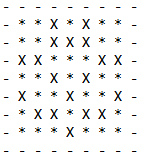I have a 7x7 grid, where I want to find the least amount of "marked positions" so a group of non-marked positions aren't bigger then 4 (only moving up, down, left and right and not diagonal). Below is an example with a solution of using 19 marked symbols.
Can anyone come up with a solution using only 18 or less?

